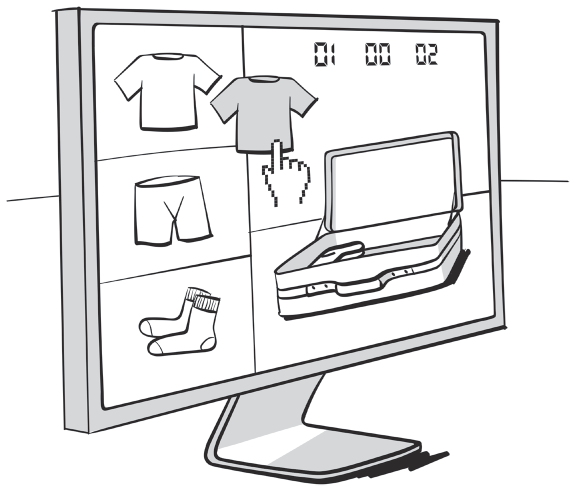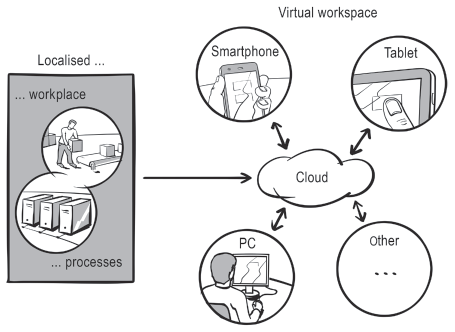Virtualisation
Flying to the cloud & co.

The pattern
The digitalisation of many aspects of our lives has enabled the use of an increasingly popular business model pattern building on decreasing server costs and always-connected Internet access: Virtualisation. Describing the imitation of a traditionally physical process in a virtual environment (HOW?), the advantage for the customer is the ability to interact with the respective value-creating process from any location or device (WHAT?). Bringing their offerings to intangible spheres (e.g. digital) provides additional opportunities for service expansion (e.g. storage upgrades, cross-sales). In exchange, the customer pays for access to the virtualised service.

A physical process can be virtualised with or without information technology. For example, consider the process of buying a book. This has traditionally involved physical interaction between buyers and sellers. One way to virtualise this process is through a paper-based catalogue allowing book purchases without physical interaction. Another way to virtualise the process is through a website (e.g. Amazon.com). In the first case, the process is virtualised via a paper-based mechanism; in the second case, via an IT-based mechanism. This illustrates that processes may be virtualised via different mechanisms.
Focusing on the currently more-relevant IT-based mechanisms, these promise everywhere accessibility, combined with an expanding multi-device ownership from the customer side. The switch of the value delivery place to the digital space makes it possible for companies to include direct adjustments of their value proposition through updates or upgrades. Moreover, as the business model pattern builds on ongoing access from the users, this allows companies to communicate directly with the customers to interact from both feedback and marketing regards. Similar to other digitalised business models, virtualised services can be easily scaled up, as an existing value architecture needs (only) to be made accessible to the respective customer groups. Allowing your applications to run on more systems than originally intended, improving stability and making more efficient use of resources is often very attractive in professional contexts, such as cloud storage (e.g. Dropbox).
Virtualisation: uploading services to the cloud

Virtualisation is compatible with several different business model patterns, including Subscription (#48), Flat Rate (#15) and Rent Instead of Buy (#40). Alternatively, Pay Per Use ideas (#35) can be realised with the developing IT systems and tracking possibilities. Virtualisation allows the use of background revenue stream such as Cross-Selling (#7) or Hidden Revenue (#21) by building on the customers’ virtualised process contents. Combining an appropriate revenue logic and attractive value proposition, this business model pattern holds the potential for strong Lock-In (#27).
The origins
A prominent Virtualisation attempt, before servers, computers and other digital machines were yet in existence, was the organised distance education of the 18th and 19th centuries. At that time, different innovative education entities in different countries overcame the presumed necessary physical interaction in formal education courses through Virtualisation. With different approaches, education pioneers such as Charles Toussaint and Gustaf Langenscheidt advanced the now-common correspondence teaching. Including learning activities that were virtualised in instructions, learning schedules or post-based communication to hand-in assignments, receiving corrections and posing questions, this pre-computer Virtualisation allowed users to benefit from the same value propositions as Virtualisation business model patterns offer today: that is, interacting with the (learning) process from any location, at any time.
The innovators
Dropbox is a household name today. By applying the Virtualisation pattern on physical digital storage, it was one of the first of now-many cloud storage providers to facilitate data sharing when mobile phones and computers are connected with the Internet. Although Dropbox’s business model is mostly known for its Freemium pricing (#18), the Virtualisation aspect builds the foundation of the value proposition to enable ubiquitous accessibility, additional software services and advanced digital collaboration possibilities to make physical storage redundant in many cases (or even outperform it).
As part of Amazon Web Services, Amazon WorkSpaces relocates your Windows or Linux desktop with all its functions to the cloud, accessible from all common devices and appropriate for different infrastructure scenarios (desktops, mobiles, bring-your-own devices). Targeting professional customers, employees’ workstations can be easily equipped with a firm’s operating system and synchronised with respect to the individual software requirements or system-wide adjustments. Offering different packages (e.g. Value, Standard, Performance), which include different services in terms of included programs or server capacities, clients can also choose their preferred payment plan (e.g. hourly, monthly).
The online service DUFL virtualised the storage and transportation of individuals’ clothes, with a special focus on travellers. By storing one’s clothes in a private DUFL closet, users can pack their suitcase online and via the DUFL app. The suitcase can be sent to any accommodation on the globe and will be picked up on demand, so the clothes can be cleaned and stored for the next trip. Allowing holiday and business travellers to go on a journey without suitcases but with the clothes awaiting them in the hotel, DUFL now also offers a packaging and shipping service to sportspeople such as golfers or skiers, which not only minimises transportation efforts but also solves the potential baggage-restriction issues of airlines and other tour operators.
When and how to apply Virtualisation
Virtualisation suits opportunities where multi-device access is given, additional value can be added digitally or when physical distances are a roadblock. Companies must be aware of the significantly changing value delivery processes, including maintenance and offering expansion, so that the business model innovation leads to a sustainable revenue generation. Providing both value proposition opportunities and value delivery challenges, firms can start by virtualising their existing services to complement established offerings. From large similarities with former, more physical, service offerings, this allows customers to transfer slowly but surely towards the new business model, which then can be enhanced through additional value-creating activities.
Some questions to ask
- Do we offer a service to the customer that requires ongoing updates and adjustments that are software-based?
- Do (or could) our customers use our service in a meaningful way on multiple devices?
- Is our service compatible with existing infrastructures and can it be easily implemented?
- Does our service show potential for expansion with other value propositions that may also result in an enhanced Lock-In of our customers?
